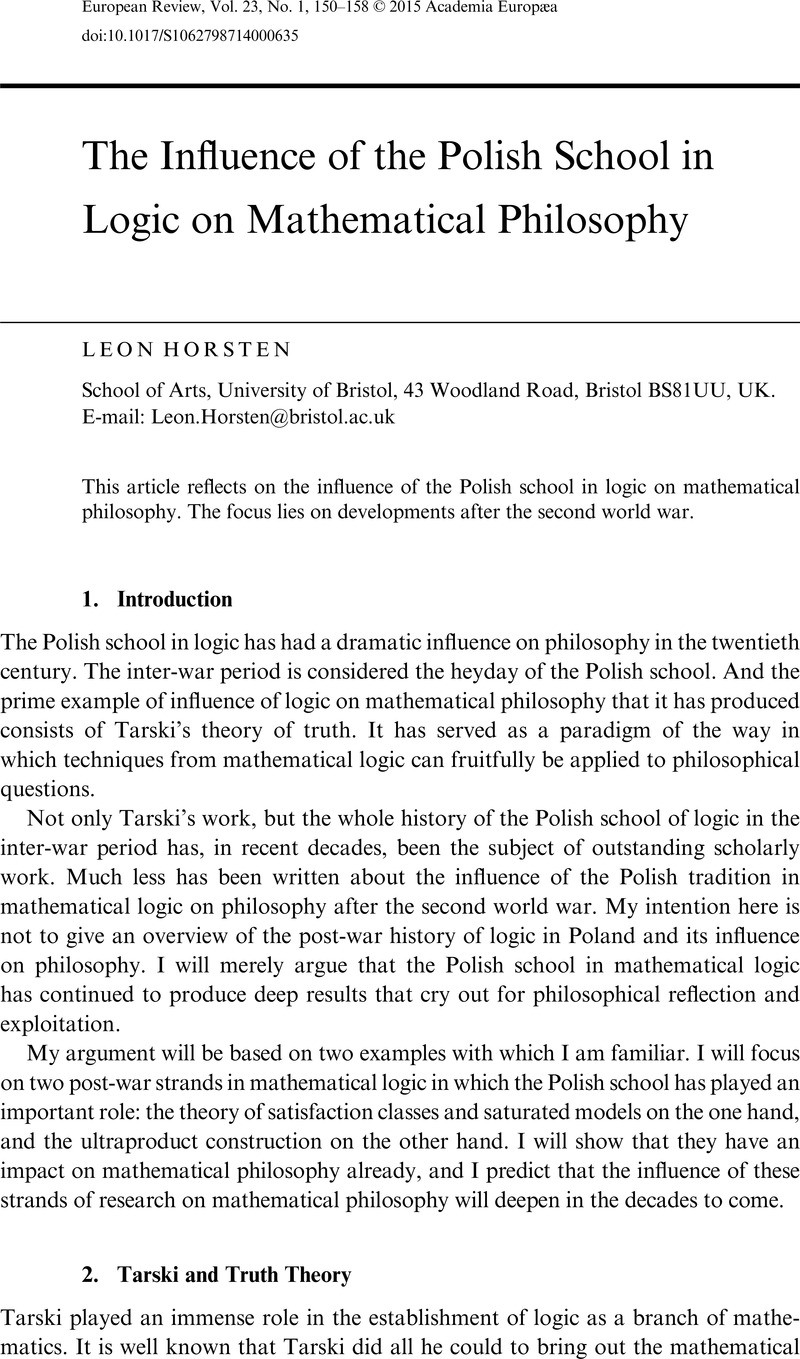No CrossRef data available.
Article contents
The Influence of the Polish School in Logic on Mathematical Philosophy
Published online by Cambridge University Press: 29 January 2015
Abstract
An abstract is not available for this content so a preview has been provided. Please use the Get access link above for information on how to access this content.

- Type
- Focus: Logic and Philosophy in Poland
- Information
- Copyright
- © Academia Europaea 2015
References
1.Tarski, A. (1935) The concept of truth in formalized languages. In: A. Tarski Logic, Semantics, Meta-mathematics. Translated by J. H. Woodger. Second, revised edition (Indianapolis: Hackett, 1983), pp. 152–278.Google Scholar
2.Carnap, R. (1950) The Logical Foundations of Probability. (Chicago: University of Chicago Press), chapter 1.Google Scholar
3.Horsten, L. (2013) Mathematical philosophy? In: H. Andersen et al. (eds), New Challenges to Philosophy of Science. (Dordrecht, Heidelberg, New York, London: Springer), pp. 73–86.Google Scholar
4.Leitgeb, H. (2013) Scientific philosophy, mathematical philosophy, and all that. Metaphilosophy, 44, pp. 267–275.Google Scholar
5.Horsten, L. and Douven, I. (2008) Formal methods in the philosophy of science. Studia Logica, 89, pp. 151–162.Google Scholar
6.Hodges, W. (2008) Tarski’s Theory of Definition. In: D. Patterson (ed.), New Essays on Tarski and Philosophy, (Oxford: Oxford University Press), pp. 94–132.CrossRefGoogle Scholar
7.Horsten, L. (2011) The Tarskian Turn. Deflationism and Axiomatic Truth (Cambridge, MA: MIT Press), chapter 2.Google Scholar
8.Kripke, S. (1975) Outline of a theory of truth. Reprinted in R. Martin (ed.), (1983) Recent Essays on Truth and the Liar Paradox (Oxford: Oxford University Press), pp. 53–81.Google Scholar
9.Gupta, A. and Belnap, N. (1993) The Revision Theory of Truth (Cambridge, MA: MIT Press).CrossRefGoogle Scholar
10.The concept of interpretability was discovered and investigated by Tarski after the Second World War.Google Scholar
11.Montague, R. (1974) Formal Philosophy: Selected Papers of Richard Montague. Edited and with an introduction by Richmond H. Thomason (New Haven: Yale University Press).Google Scholar
12.Tarski, A. (1986) What are logical notions? Edited (with an introduction) by John Corcoran History and Philosophy of Logic, 7, pp. 143–154.Google Scholar
13.Wolenski, J. (1989) Logic and Philosophy in the Lvov-Warsaw School (Dordrecht, Boston, London: Kluwer).Google Scholar
14.Simons, P. (2002) Reasoning on a tight budget: Lesniewski’s nominalistic metalogic. Erkenntnis, 56, pp. 99–122.Google Scholar
15.Betti, A. (2004) Lesniewski’s early liar, Tarski and natural Language. Annals of Pure and Applied Logic, 127, pp. 267–287.Google Scholar
16.Mostowski stayed in Europe, but also in set theory Tarski and his disciples set the agenda after the Second World War.Google Scholar
17.Mostowski was an immensely influential figure in the Polish school of mathematical logic after the second world war. See A. Ehrenfeucht et al. (eds), Andrzej Mostowski and Foundational Studies. (Amsterdam: IOS Press).Google Scholar
18.For a detailed discussion of CT, see V. Halbach (2011) Axiomatic Theories of Truth (Cambridge: Cambridge University Press), chapter 8; or L. Horsten (2011) The Tarskian Turn. Deflationism and Axiomatic Truth (Cambridge, MA: MIT Press), chapter 6.Google Scholar
19.Horsten, L. (2011) The Tarskian Turn. Deflationism and Axiomatic Truth (Cambridge, MA: MIT Press).Google Scholar
20. Even some of the strongest mathematical logicians of the twentieth century have fallen for this: see for instance S. Feferman (1991) Reflecting on incompleteness. Journal of Symbolic Logic, 56, pp. 1–49, Lemma 2.4.2.Google Scholar
21.Lachlan, A. (1981) Full satisfaction classes and recursive saturation. Canadian Mathematical Bulletin, 24, pp. 295–297.CrossRefGoogle Scholar
22.Kotlarski, H., Krajewski, S. and Lachlan, A. (1981) Construction of satisfaction classes for nonstandard models. Canadian Mathematical Bulletin 24, pp. 441–454.Google Scholar
23.Kotlarski died some years ago: see (2010) In Memoriam: Henryk Kotlarski Bulletin of Symbolic Logic 16, p. 145.Google Scholar
24.Barwise, J. and Schlipf, J. (1976) An introduction to recursively saturated and resplendent models. Journal of Symbolic Logic, 41, pp. 531–536.CrossRefGoogle Scholar
25.Indeed, more is true. Not even the theory TB, which consists of PA (with truth allowed in the induction scheme) plus the Tarski-Biconditional sentences of the form  $T(\overline{{g(A)}} )\, \leftrightarrow \,A$
, where A ranges over arithmetical sentences and g is the function that assigns Gödel codes to sentences, is semantically conservative over PA. See A. Strollo (2013) Deflationism and the invisible power of truth. Dialectica, 67, pp. 521–543.Google Scholar
$T(\overline{{g(A)}} )\, \leftrightarrow \,A$
, where A ranges over arithmetical sentences and g is the function that assigns Gödel codes to sentences, is semantically conservative over PA. See A. Strollo (2013) Deflationism and the invisible power of truth. Dialectica, 67, pp. 521–543.Google Scholar
26.Fischer, M. and Horsten, L. (2014) The expressiveness of truth. To appear in Review of Symbolic Logic.Google Scholar
27.Łoś’, J. (1955) Quelques remarques, théorèmes et problèmes sur les classes définissables d’algèbres. In: T. Skolem et al. (eds), Mathematical Interpretation of Formal Systems (Amsterdam: North-Holland), pp. 98–113.Google Scholar
28.Robinson, A. (1961) Non-standard analysis. Nederlandse Academie van Wetenschappen Proceedings Series A, 64; and Indagationes Mathematicae, 23, pp. 432–440.Google Scholar
29.Kolmogorov, A. N. (1933) Grundbegriffe der Wahrscheinlichkeitrechnung (Ergebnisse Der Mathematik). Translated by N. Morrison Foundations of Probability (New York: Chelsea Publishing Company, 1956), 2nd English edition.Google Scholar
30. The Kolmogorov axioms include the principle of σ-additivity.Google Scholar
31.Wenmackers, S. and Horsten, L. (2013) Fair infinite lotteries. Synthese, 190 pp. 37–61.Google Scholar
32.Benci, V., Horsten, H. and Wenmackers, S. (2013) Non-Archimedean probability. Milan Journal of Mathematics, 81, pp. 121–151.Google Scholar
33. Instead of σ-additivity, these probability functions satisfy a generalised form of infinite additivity.Google Scholar
34.Williamson, T. (2007) How probable is an infinite sequence of heads? Analysis, 67, pp. 173–180.Google Scholar
35.Easwaran, K. (2014) Regularity and hyperreal credences. Philosophical Review, 123, pp. 1–41.Google Scholar
36.Pruss, A. (2012) Infinite lotteries, perfectly thin darts, and infinitesimals. Thought, 1, pp. 81–89.Google Scholar
37.Benci, V., Horsten, H. and Wenmackers, S.. Infinitesimal probabilities. Submitted for publication.Google Scholar
38.Wolenski, J. (2013) Lvov-Warsaw school. Stanford Encyclopedia of Philosophy. Stanford, CSLI, http://plato.stanford.edu/entries/lvov-warsaw/Google Scholar




